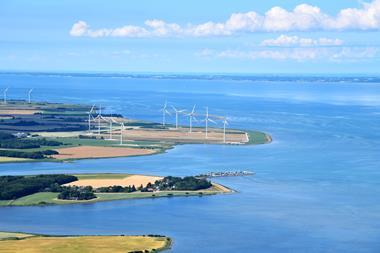Despite being the most abundant chemical element in the universe, hydrogen presents some technical and technological challenges to convert it into usable green fuel, a panel discussion told delegates at the IPE Real Assets & Infrastructure Global Investor Conference & Awards 2023.
In a keynote presentation, Ed Buddenbaum, programme manager at GroenvermogenNL, said the Netherlands has a strong ambition to be climate-neutral by 2050 and fully circular. To achieve this, the country has set a target of reducing greenhouse gas emissions by at least 55% by 2030.
Buddenbaum said hydrogen, and most specifically green hydrogen, has a role to play in the energy transition.
One key component of the Dutch energy transition policy is green hydrogen. The country has a number of advantages in this area, including its offshore wind resources, existing gas grid and proximity to major European markets, Buddenbaum said at last week’s event in Amsterdam.

The Dutch government has established a National Programme on Hydrogen to accelerate the use of green hydrogen in the country. The programme is focused on innovation, pilot and demo projects and human capital development.
The government has made over €838m available to GroenvermogenNL under the national growth fund to accelerate the use of green hydrogen in the Netherlands to fight climate change and boost earning power.
Buddenbaum said what the hydrogen sector required was innovation on R&D, pilot and demo support, and human capital, something GroenvermogenNL has identified as needed and is working on.
Buddenbaum thinks that the government does not necessarily need direct involvement in solving the problems of rising supply chain prices and interest rates, but it should play a more active role in streamlining the permitting process for hydrogen projects.
In addition, permitting bodies in the Netherlands still lack knowledge about safety precautions and standards for hydrogen projects, Buddenbaum said, adding that government support should go beyond subsidies to include participation and subordinated loans.
“Working together is essential to take the first steps towards a hydrogen transition,” he said.
Buddenbaum’s presentation was followed by a panel discussion, moderated by Lauren Mills, private markets editor at IPE Real Assets.
Buddenbaum joined panel members Robert Arnold, sustainability research director at EDHEC-Risk Climate Impact Institute, Tom Houghton, partner at ERM, and Art Pithayachariyakul, Sustainable Energies principal at CPP Investments.
The panellists discussed what was needed to make hydrogen investable and play a meaningful role in the energy transition, including the cost and safety of the hydrogen distribution systems.
“I think what has been presented today really highlights some of the critical issues associated with the development of hydrogen and its use within the energy system,” Houghton said as he elaborated on Buddenbaum’s presentation.
He said there was a need to integrate hydrogen into the energy system. ”We need to consider the fact that it impacts many different parts of that energy system. And you really need a kind of a wholesale approach to considering how you do that when there are other technologies that you can bring into the energy system which can be point solutions and which can be integrated into the existing energy system. I think with hydrogen, you need to think a little bit more holistically about that.”
Houghton said there was a need for policy support. “Stable and ongoing support will be critical to the business models that we see emerging to support hydrogen,” he said.
He cited the Innovation Fund in Europe and the UK’s Net Zero Hydrogen Fund as examples of capital support.
Pithayachariyakul highlighted the human capital aspect of the hydrogen industry, which he said was critical and rarely mentioned as frequently or as prominently as financial capital.
“Nothing happens without the right capability in the right place,” he said. “We think there’s a way to unlock a bigger capital to activate the sector. However, that won’t happen until we start to think about some of the risk factors in handling hydrogen.”
For this reason, CPP Investments is first working with “current users of hydrogen, because we think they’re well equipped to handle some of the less positive aspects of the physical nature of hydrogen”.
Pithayachariyakul said: “It also gives that workforce another avenue in terms of job security and further growth, and start to kickstart this ecosystem. But the human capital, the support programme that goes into training and maintaining the capability to execute this transition is key for us.”
Hydrogen is a versatile tool for decarbonising the energy system, but its role will vary depending on a country’s existing infrastructure, Arnold said, countries with well-developed gas and oil infrastructure, such as the Netherlands and the UK, are in a good position to deploy hydrogen for a variety of uses. Countries with less developed infrastructure may need to focus on more specific applications, such as synthetic fuels or the chemical industry.
”The growth of the hydrogen market will depend on whether it is supply-driven or demand-driven.” Blue hydrogen, which is produced from natural gas using carbon capture and storage, is a relatively early and high-volume source of hydrogen. However, it is not possible to produce blue hydrogen everywhere in the world, he added.
Arnold said investors must carefully consider where to direct their investments in the hydrogen sector, given the many possibilities and the varying strengths of different locations. “I think in some ways hydrogen is a victim of its own potential success and versatility that you have so many possibilities at the moment,” he said. “But actually, it’s trying to identify where those possibilities play out and what the strengths are in different locations that will define where you’re going to put your money.”
Buddenbaum said that European and Dutch policy is in favour of green hydrogen, which is produced using renewable energy. However, this policy tends to neglect the transition towards markets being able to address this.
He believes that blue hydrogen, which is produced from natural gas with carbon capture and storage, is a stepping stone towards a totally green hydrogen future.
In contrast, the US Inflation Reduction Act does not make a distinction between green and blue hydrogen, supporting both. This is making it easier to invest in the hydrogen sector in the US, and the Dutch government and European Union are trying to emulate some of this.
Buddenbaum said it was wise to look into the transition towards green hydrogen without abolishing blue hydrogen. He also sees a role for blue hydrogen in the short term, as it could be imported from the Middle East to Northern Europe. However, he believes that R&D should focus on green hydrogen, as this is the future in the long run.























